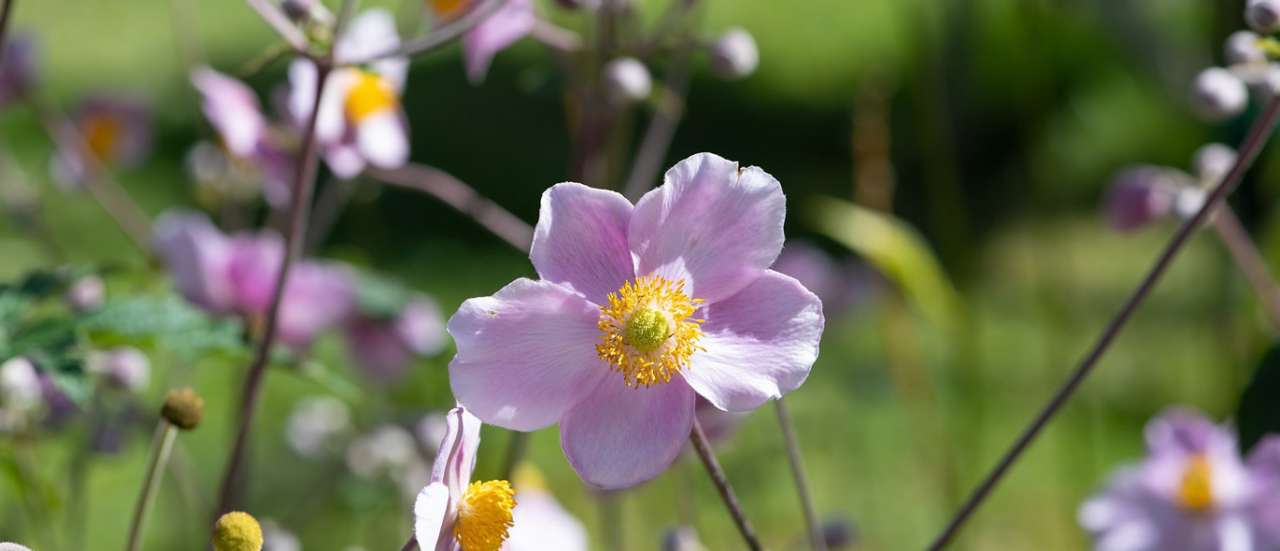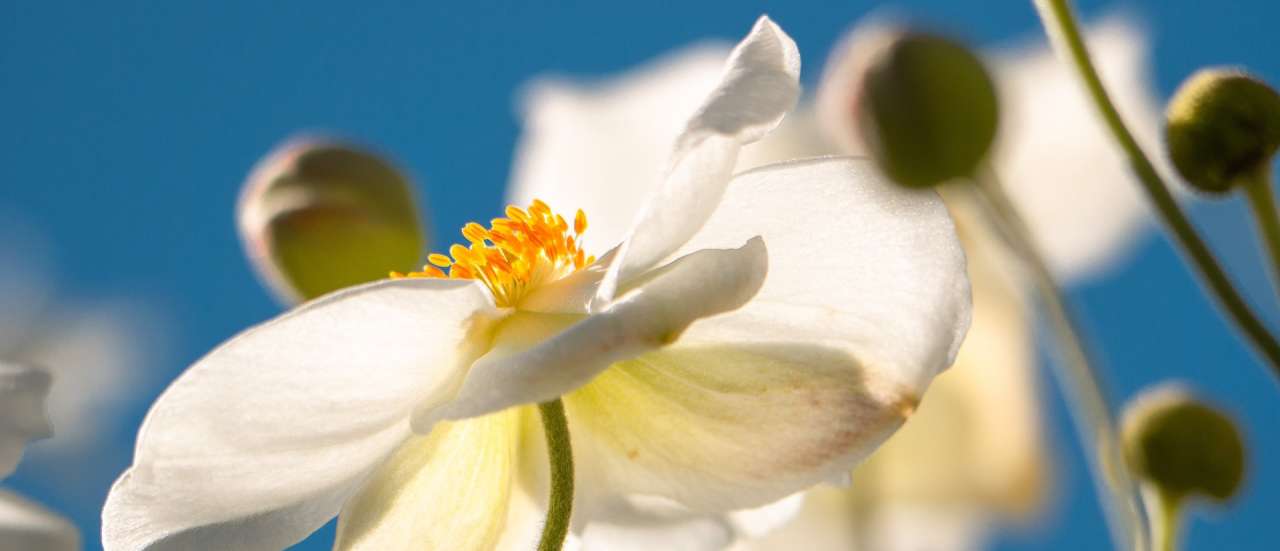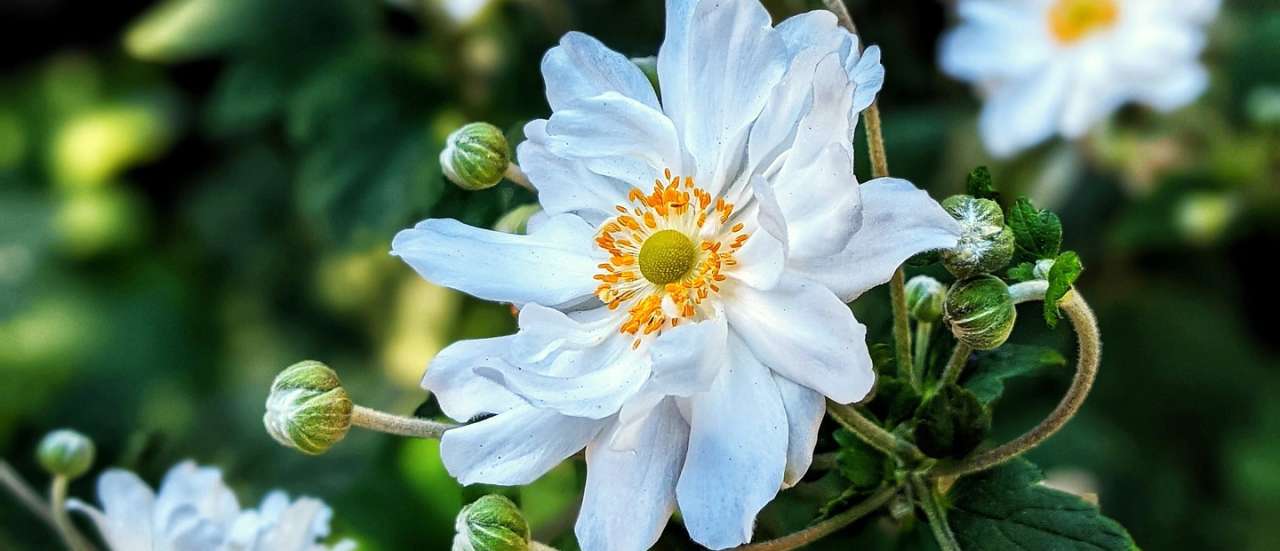Japanese anemones provide a splash of colour, in a mix of pink or white flowers, some even with a splash of purple, at a time of year when many other flowering plants are starting to fade. With a long blooming season of 6-8 weeks, this also makes them a welcome addition to a garden for anyone who has wildlife in mind as they provide valuable pollen and nectar to late flying pollinators, including bumblebees.
The fact that these plants are vigorous, spreading and usually reach a height of about 3-5ft tall, makes them perfect for lining the mid to back section of a border.
 Japanese Anemone - Image by Petra from Pixabay
Japanese Anemone - Image by Petra from Pixabay
Where and How to grow:
As Japanese anemones thrive in shade and require rich, moist soil, they make an excellent choice for planting under trees, in woodland locations and brightening up a shady part of your garden. They even work well in large containers (with careful attention to watering).
Japanese anemones should be grown in a moist but well-draining soil in a partially shaded area for best results. For continuous flowering through late summer and autumn, be sure to deadhead regularly and give an annual mulch in winter or even early spring, when you can also tidy up any dead or messy foliage.
It is worth noting that Japanese anemones spread by their rhizomes underground and so these are not advised for a garden that may have limited space and even in larger gardens you will need to consider this when selecting a position for them.
Anemones are similar to other perennials when it comes to planting but there are a couple of extra things to take into consideration:
- As mentioned before, these plants are pretty vigorous once established and require a bit of space. They also thrive in fertile, moist soils that don't get waterlogged and don't get too dry. With this in mind it is worth digging in organic matter over a wide area, where you envisage the plant to spread and fill out (as opposed to just adding compost in the potting hole).
- Once you have prepared the area you can just dig a hole as deep as the pot you bought it in and just a little wider.
- Remove the plant from the pot and loosen any roots that may have become rootbound i.e. wrapped tightly around themselves in the pot.
- Place the root-ball in the the hole, insuring the plant remains at the same depth as it was in the pot, then back-fill around the plant and firm the plant in gently.
- Water in well and apply a mulch to keep the moisture in the soil. If you are planting in the summer season you will need to water regularly through dryer periods until the roots are established.
 White Japanese Anemone - Image by Christel from Pixabay
White Japanese Anemone - Image by Christel from Pixabay
Japanese Anemone care:
Japanese anemones are pretty low maintenance. You can cut them back after flowering or leave the seed heads on over winter to offer the birds some extra food. It's just a case of tidying up the foliage in spring to allow for fresh new growth and maybe adding a mulch around this time to give them a boost for the season. Clumps can be divided every few years in autumn or spring. When you do divide and relocate plants, they may look unhappy for a while (it can take a year or so for them to flower again) but they will bounce back.
As Japanese anemones can self seed as well as spread via their rhizomes, in perfect conditions they can become somewhat invasive. This is easily controlled by removing any unwanted new shoots as they appear plus dividing and replanting established clumps should keep them under control.
Propagation:
We have already mentioned that you can divide clumps in autumn or spring to create new plants, which you can do by lifting the plant and dividing the root-ball into sections using a sharp knife (an old bread knife is perfect for this kind of job) and replanting.
As this plant spreads by its rhizomes, you can also create new plants by taking root cuttings. This is probably the best method as you can do this without lifting the clump and upsetting the plant. Instead just dig down beside the plant, find yourself a fleshy root and snip it off with a sharp knife.
Each root cutting that you plant should be about 5-10cm (2-4") in length. You need to simply lay these cuttings horizontally onto trays of moist but free draining compost. Keep the compost moist but not soaking wet and these cuttings will start to develop roots and shoots. These sections can then be potted on until you have a reasonable sized plant to put in your garden or final container and should establish well and flower within two years.
You can also propagate by seed but these plants can take a number of years to produce flowers and so we wouldn't recommend it unless you are particularly patient.
Anemone Planting Companions
Whilst they look great in a swathe all of their own, there are some great companion plants that will extend the season and interest of your border alongside these late blooming lovelies:
- As these plants love partial shade, they are the perfect companion to other shade loving plants like hostas, ferns and hakonechloa. These lovely foliage plants will provide substance and texture throughout the seasons.
- Japanese anemones are fairly tall plants in bloom, reaching 3-5ft tall and so are best suited to the mid or back section of a border. This gives you an opportunity to fill the front of the border with other late flowering plants that complement the floating white, pink or purple tinted flowers of the anemones behind them. Perennials such as Aster, Echinacea and Rudbeckia are perfect for the job and your choice will depend on whether you want something calming and subtle, as with a purple aster or pink echinacea, or something more vibrant and contrasting as with the bright yellow rudbeckia.
- Hardy geraniums planted at the front of a border of anemones is also a perfect low maintenance choice. Mixing with long flowering varieties like Rozanne for instance, that will provide purple flowers in the border much earlier in the season and so extending interest through the year. The beauty of something like Rozanne is that it will still remain in flower for most of the period the anemones are in bloom, after which the autumn foliage will extend the border's interest.
If your looking for more inspiration or ideas, browse our selection online or visit one of our stores where our staff will be happy to help and offer further advice.
 Anemone Ruffled Swan - Image by Cindy from Pixabay
Anemone Ruffled Swan - Image by Cindy from Pixabay








